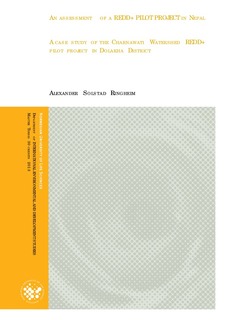An assessment of a REDD+ PILOT PROJECT in Nepal : a case study of the Charnawati Watershed REDD+ pilot project in Dolakha District
Abstract
The REDD+ initiative, which is an acronym for “Reduce Emission from Deforestation and
forest Degradation, and incorporates conservation, sustainable management of forests and
enhancement of forest carbon stocks. Is a mechanism which has emerged through a global
partnership under the United Nations Framework Convention on Climate Change. The project
is being implemented at various locations around the globe, the focus of this study will be the
REDD+ pilot project initiative in Nepal. Nepal has been a member of both the UN-REDD
programme and FCPF since 2010. The REDD+ readiness capacity initiative has been has
been a joint effort initiated by the Government of Nepal with the support of FCPF, who have
worked together in identifying “options for the design of an effective, efficient and equitable
fund management system for REDD+ finance, and in assessing key policies and measures for
addressing drivers of deforestation and forest degradation and linkages to the overall national
REDD+ Readiness. This study investigates one particular case; that of the Charnawati
watershed REDD+ pilot project, which was initiated in 2010. Through applying a case study
design and using both qualitative and quantitative methods, this thesis is structured as a
follow up evaluation of a baseline study. The objectives addressed in the thesis are;
establishing the livelihood situation of the CFUGs and their level of dependence on natural
resources (forest products in particular). Reviewing outcomes from the various livelihood
strategies along with applicable livelihood challenges, vulnerabilities and coping mechanisms
(based on the Sustainable Livelihoods Approach). The second section of the paper looks
specifically at forest governance/ REDD+ related themes including; presenting users
perceptions of climate change and CF governance, current mechanisms and practices
employed in REDD+ implementation at the local level. Reviewing the outcomes of policies
and fund distribution of the REDD+ initiative, as well as assessing users and mezzo level
perceptions of CFs and REDD+. The last section discusses the level and approach
communication between actors from the local level to the mezzo, also the potential for
weakness such as corruption, elite capture etc. As the study has been of a small scale and no
baseline study exists for the study area, some indicators have been hard to evaluate. As such
it has it has seemed appropriate under certain sections of the paper to only determine and
measure indicators. Although at times theories and reflections have been joined with findings,
it has seemed prudent to restrain from over extrapolations, and where relevant supress the
urge to transpose findings into a larger context. Based on the findings, this thesis argues
[vi]
that the community forestry approach is both accepted and approved of by community forest
users at the study site, but the REDD+ initiative, was at the time of study not well known by
forest users, and its guidelines unclear and in certain aspects in conflict with present
community forest use and management practices. The community forest users are
predominantly subsistence farmers and have a high level of dependence on forest products in
sustaining their current livelihood situation. The incentive mechanism to compensate forest
users for reducing their use of forest products is generally not seen as viable by the forest
users. Both due to the afore mentioned premise but also on account that the available REDD+
funds to compensate users for reduced forest product use are greatly under-dimensioned.
Communication challenges were uncovered between the mezzo level and macro level.
Thereof, most importantly the mezzo level being poorly informed of national directives and
lacking the ability to participation and collaboration in developing locally relevant policies.
Lastly concerning the possible approaches that may be taken to avoid the potential for elite
capture and corruption when distributing REDD+ funds, a direct method from donor local
institutions/ CFUG has been argued for.
